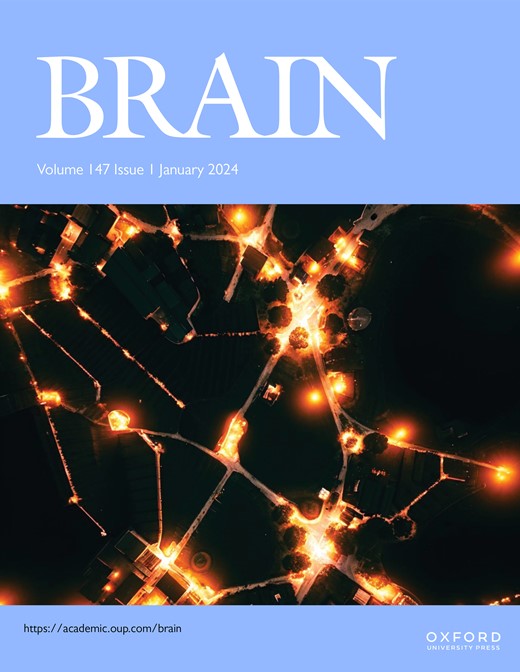Multicentre analysis of seizure outcome predicted by removal of high frequency oscillations
IF 10.6
1区 医学
Q1 CLINICAL NEUROLOGY
引用次数: 0
Abstract
In drug-resistant focal epilepsy, planning surgical resection may involve presurgical intracranial EEG recordings (iEEG) to detect seizures and other iEEG patterns to improve postsurgical seizure outcome. We hypothesized that resection of tissue generating interictal high frequency oscillations (HFOs, 80-500 Hz) in the iEEG predicts surgical outcome. Eight international epilepsy centres recorded iEEG during the patients’ pre-surgical evaluation. The patients were of all ages, had epilepsy of all types, and underwent surgical resection of a single focus aiming at seizure freedom. In a prospective analysis we applied a fully automated definition of HFO which was independent of the dataset. Using an observational cohort design that was blinded to postsurgical seizure outcome, we analysed HFO rates during non-rapid-eye-movement sleep. If channels had consistently high rates over multiple epochs, they were labelled the “HFO area”. After HFO analysis, centres provided the electrode contacts located in the resected volume and the seizure outcome at follow-up ≥24 months after surgery. The study was registered at www.clinicaltrials.gov (NCT05332990). We received 160 iEEG datasets. In 146 datasets (91%), the HFO area could be defined. The patients with completely resected HFO area were more likely to achieve seizure freedom compared to those without (OR 2.61 CI [1.15-5.91], P = 0.02). Among seizure free patients, the HFO area was completely resected in 31 and was not completely resected in 43. Among patients with recurrent seizures, the HFO area was completely resected in 14 and was not completely resected in 58. When predicting seizure freedom, the negative predictive value of the HFO area (68% CI [52-81]) was higher than that for the resected volume as predictor by itself (51% CI [42-59], P = 4e-5). The sensitivity and specificity for complete HFO area resection were 0.88 CI [0.72-0.98] and 0.39 CI [0.25-0.54] and the area under the curve was 0.83 CI [0.58-0.97], indicating good predictive performance. In a blinded cohort study from independent epilepsy centres, applying a previously validated algorithm for HFO marking without the need of adjusting to new datasets allowed us to validate the clinical relevance of HFOs to plan the surgical resection.通过去除高频振荡预测癫痫发作结果的多中心分析
对于耐药性局灶性癫痫,手术切除计划可能涉及手术前颅内脑电图(iEEG)记录,以检测癫痫发作和其他 iEEG 模式,从而改善手术后癫痫发作的预后。我们假设,切除在 iEEG 中产生发作间期高频振荡(HFO,80-500 Hz)的组织可预测手术效果。八个国际癫痫中心在对患者进行手术前评估时记录了 iEEG。这些患者年龄各异,患有各种类型的癫痫,并接受了以摆脱癫痫发作为目的的单病灶手术切除。在前瞻性分析中,我们采用了独立于数据集的全自动 HFO 定义。我们采用观察性队列设计,对术后癫痫发作结果进行了盲法分析,分析了非快速眼动睡眠期间的 HFO 发生率。如果通道在多个时程中持续出现高频率,则将其标记为 "HFO 区域"。在进行 HFO 分析后,各中心提供了位于切除区域的电极触点以及术后≥24 个月随访时的癫痫发作结果。该研究已在 www.clinicaltrials.gov(NCT05332990)上注册。我们收到了 160 份 iEEG 数据集。其中 146 个数据集(91%)可以确定 HFO 区域。与未完全切除 HFO 区域的患者相比,完全切除 HFO 区域的患者更有可能摆脱癫痫发作(OR 2.61 CI [1.15-5.91],P = 0.02)。在无癫痫发作的患者中,31 例完全切除了 HFO 区域,43 例未完全切除。在反复发作的患者中,14 例完全切除了 HFO 区,58 例未完全切除。在预测癫痫发作自由度时,HFO 面积的阴性预测值(68% CI [52-81])高于作为预测指标的切除体积本身的阴性预测值(51% CI [42-59],P = 4e-5)。完全切除 HFO 面积的灵敏度和特异度分别为 0.88 CI [0.72-0.98] 和 0.39 CI [0.25-0.54],曲线下面积为 0.83 CI [0.58-0.97],表明预测效果良好。在一项来自独立癫痫中心的盲法队列研究中,应用之前验证过的HFO标记算法,无需根据新的数据集进行调整,就能验证HFO与手术切除计划的临床相关性。
本文章由计算机程序翻译,如有差异,请以英文原文为准。
求助全文
约1分钟内获得全文
求助全文
来源期刊

Brain
医学-临床神经学
CiteScore
20.30
自引率
4.10%
发文量
458
审稿时长
3-6 weeks
期刊介绍:
Brain, a journal focused on clinical neurology and translational neuroscience, has been publishing landmark papers since 1878. The journal aims to expand its scope by including studies that shed light on disease mechanisms and conducting innovative clinical trials for brain disorders. With a wide range of topics covered, the Editorial Board represents the international readership and diverse coverage of the journal. Accepted articles are promptly posted online, typically within a few weeks of acceptance. As of 2022, Brain holds an impressive impact factor of 14.5, according to the Journal Citation Reports.
 求助内容:
求助内容: 应助结果提醒方式:
应助结果提醒方式:


